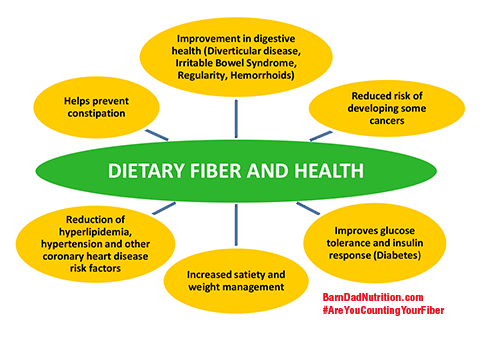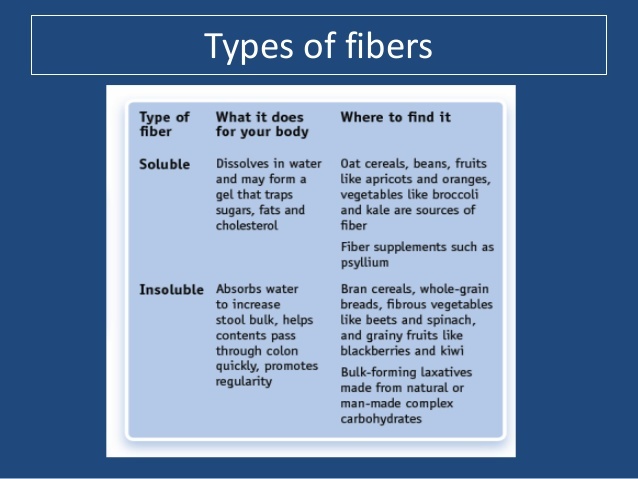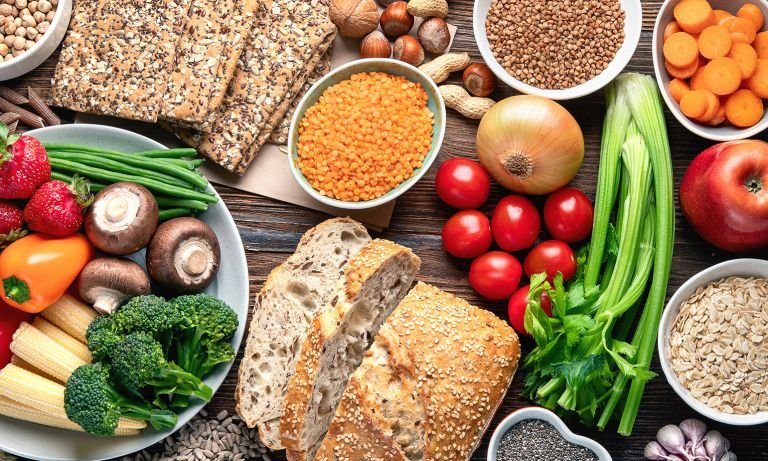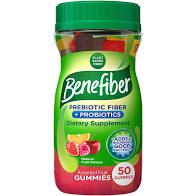There is a substance in some foods essential to our health, yet it is not a nutrient. This substance is fiber, also known as dietary fiber. There are other facts about this mysterious substance, so this article is all about dietary fiber.
What is Dietary Fiber?
First, dietary fiber is not a nutrient because it is not digested and absorbed by the human body. Also known as roughage, dietary fiber is the indigestible part of plant foods. This substance has a multitude of health benefits, including reducing the risk of type 2 diabetes and heart disease.
Where is Dietary Fiber Found?
Fiber is established primarily in vegetables, fruits, whole grains, and legumes. There are two (2) types of fiber, soluble and insoluble, and they both play essential roles in health:
- Insoluble fiber does not disperse in water and adds bulk to the stool, which prevents constipation.
- On the other hand, soluble fiber absorbs water, forming a gel-like substance in the digestive system. Soluble fiber can aid in lowering cholesterol levels and help manage blood sugar levels.
Health Benefits of Dietary Fiber
Dietary fiber is a central element of a healthy diet. It is vital for keeping the gut healthy and reducing the risk of chronic health conditions.
The majority of people in the U.S. do not get enough fiber from their diets. According to some estimates, only 5% of the population meets the adequate intake recommendations for dietary fiber. This small percentage indicates that most people in the U.S. could obtain health advantages from increasing their daily fiber intake.
Eating fiber has many health benefits. Some are listed below:
Protects against heart disease – Numerous studies over the past decades have examined dietary fiber’s effect on heart health, including preventing cardiovascular disease and reducing blood pressure.
In a 2017 review of studies, it was established that individuals eating high fiber diets had a considerably reduced risk of cardiovascular disease and lower fatality from these conditions.
It is said that these heart-protective effects may be because fiber reduces total cholesterol and low-density lipoprotein (LDL) cholesterol, also called ‘bad cholesterol,’ which is a primary risk for heart conditions.
Promotes a healthy gut – Fiber is essential for keeping the gut healthy. Eating sufficient fiber can prevent or relieve constipation by helping waste to move smoothly through the body. It additionally encourages healthy gut microbiota.
Dietary fiber produces increased fecal mass, frequency, and regularity of expelling feces, the reduced transit time of fecal material through the large intestine, and reduced stool solidity. The softer stool will result in less distress to the colon and anus and less pressure on the muscles involved in defecation.
According to a 2015 review, dietary fiber increases the bulk of stool, aids with promoting regular bowel movements, and lessens the time that waste spends inside the intestines.
According to a 2009 review, dietary fiber has a significant impact on gastrointestinal disorders, including:
- colorectal ulcer
- diverticular disease
- gastroesophageal reflux disease
- hemorrhoids
- hiatal hernias

The Benefits of Dietary Fiber
A 2019 review indicates that fiber ingestion may decrease an individual’s
risk of colorectal cancer.
Reduced risk for diabetes – Adding more fiber to the diet may additionally have benefits for diabetes. Fiber can assist in slowing down the body’s absorption of sugar, helping to prevent blood sugar spikes after meals.
A 2018 review indicates that individuals who consumed high fiber diets, particularly cereal fiber, had a lower risk of developing type 2 diabetes. These persons also reported a slight reduction in blood glucose levels.
Weight Management – For individuals seeking to lose weight, a diet high in dietary fiber can aid in regulating weight loss. Foods high in fiber can help a person feel fuller for longer and help people adhere to a diet.
In a 2019 study, researchers determined that individuals who increased their dietary fiber intake increased their weight loss and dedication to their dietary caloric restrictions.
Types of Dietary Fiber
Fiber contains nonstarch polysaccharides, for example, cellulose, dextrins, inulin, lignin, chitins, pectins, beta-glucans, waxes, and oligosaccharides.
As mentioned earlier, soluble and insoluble are the two types of dietary fiber.

Most high fiber-containing foods have both insoluble and soluble fiber, so individuals do not need to think much about the difference. However, they can focus on the whole fiber intake.
Soluble fiber – Soluble fiber liquefies in water and forms a gel-like substance in the stomach. Later, bacteria break the gel down in the large intestine. Soluble fiber yields a few calories to the individual.
Soluble fiber supplies the following benefits:
- lowering LDL cholesterol in the blood by affecting how the body takes in dietary fat and cholesterol
- slows the absorption of other carbohydrates through digestion, which can aid with the normalizing of blood sugar levels
Excellent supplies of soluble fiber can be found in:
- beans
- fruits
- nuts
- oats
- vegetables
Insoluble fiber – Insoluble fiber does not dissolve in water and passes through the gastrointestinal tract, generally whole. It provides no calories.
Insoluble fiber assists in forming bulk in the stool, which helps a person pass stool faster. It can also aid in the avoidance of constipation.
Good quality sources of insoluble fiber include:
- fruits
- nuts
- vegetables
- whole-grain foods
Plant-based foods are a superb supplier of dietary fiber. A few forms have more fiber than others.
Below are 38 high-fiber foods. They are some examples with their fiber contents according to the Dietary Guidelines for Americans 2015–2020:
| Food item | Serving portion | Calories | Dietary fiber in grams |
| High fiber bran (ready-to-eat cereal) | ½–3/4 of a cup | 60–81 | 9.1–14.3 |
| Chickpeas, canned | 1/2 a cup | 176 | 8.1 |
| Lentils, cooked | 1/2 a cup | 115 | 7.8 |
| Cooked pinto beans, | 1/2 a cup | 122 | 7.7 |
| Black beans, cooked | ½ a cup | 114 | 7.5 |
| cooked lima beans | 1/2 a cup | 108 | 6.6 |
| White beans, canned | ½ a cup | 149 | 6.3 |
| Kidney beans | 1/2 a cup | 112 | 5.7 |
| Wheat bran flakes (ready-to-eat cereal) | 3/4 of a cup | 90–98 | 4.9–5.5 |
| Raw pear | 1 medium fruit | 101 | 5.5 |
| Canned baked beans, plain | 1/2 a cup | 119 | 5.2 |
| Avocado | 1/2 a cup | 120 | 5.0 |
| Cooked mixed vegetables, from frozen | 1/2 a cup | 59 | 4.0 |
| Raspberries | ½ a cup | 32 | 4.0 |
| Blackberries | 1/2 a cup | 31 | 3.8 |
| Collards, cooked | 1/2 a cup | 32 | 3.8 |
| Baked sweet potato, in skin | 1 medium vegetable | 103 | 3.8 |
| Popcorn, air-popped | 3 cups | 93 | 3.5 |
| Almonds | 1 ounce (oz) | 164 | 3.5 |
| Whole wheat spaghetti, cooked | 1/2 a cup | 87 | 3.2 |
| Orange | 1 medium fruit | 69 | 3.1 |
| Banana | 1 medium fruit | 105 | 3.1 |
| Bran muffin, oat | 1 small muffin | 178 | 3.0 |
| Pistachios, dry roasted | 1 oz | 161 | 2.8 |
| Pecans, oil roasted | 1 oz | 203 | 2.7 |
| Quinoa, cooked | half a cup | 111 | 2.6 |
Fiber supplements
Individuals who are sensitive to high fiber foods may find it challenging to get sufficient fiber. In that case, they should consult with their physician about obtaining sources of fiber that will not cause an allergic reaction.
In such cases, an individual may want to consult with their doctor about fiber supplements. A doctor may advise these if the individual has constipation or trouble passing stool. Drug stores sell fiber supplements, such as Metamucil, Citrucel, Benefiber, and FiberCon. SHOP FOR FIBER SUPPLEMENTS ONLINE [affiliate link]
However, these products do not provide the same levels of vitamins and nutrients as natural, high-fiber foods. Nevertheless, they are beneficial when someone is unable to get enough fiber from their diet.
The following categories of individuals should use dietary supplements to make sure they are getting a sufficient amount of dietary fiber:
- Individuals who constantly eat or drink out and are troubled about high blood sugar.
- Individuals who often consume high-fat foods and who are concerned about high cholesterol levels.
- Individuals whose blood pressure is elevated.
- Individuals with erratic mealtimes and who are troubled about obesity.
- Individuals who have a propensity to have constipation.
Signs of a Fiber Deficiency
If a diet is short on fruits, vegetables, and whole grains, it may not be yielding all the fiber required, raising the risk for weight gain, heart disease, and cancer.
While the symptoms of a fiber-poor diet aren’t always obvious, there are four key (4) warning signs to watch for:
Constipation – If an individual has fewer than three (3) bowel movements a week, and the stools are hard and dry, that is constipation. Constipation can result from a lack of fiber but also too little exercise and certain medications and supplements.
If the constipation is diet-related, it may be relieved by adding more fiber-rich foods such as broccoli, carrots, apples, raspberries, or whole grains.
Boosting fiber intake can help form soft, bulky stools, preventing and relieving constipation. It is best to add fiber slowly, enabling the body to get used to it. It also helps to stay regular by drinking plenty of fluids and exercising consistently.
Weight Gain- Fiber adds to fullness. The fullness one receives after a meal. If an individual is not experiencing that feeling, they may be eating more than their body requires.
In that case, it’s best to attempt to meet the recommended goal of 25 to 35 grams of fiber each day by enjoying fiber-filled foods like fresh fruit, whole grains, and seasonal vegetables. Choosing the fiber-rich foods enjoyed the most will more likely lead to eating favorites often.
Blood Sugar Fluctuations – If an individual has diabetes and finds controlling their blood sugar not easy, they should talk to their doctor: they may not be getting enough fiber.
Since fiber hinders the absorption of sugar, assisting with the control of blood sugar levels, it would be wise to try adding more fresh produce, beans and peas, brown rice, and other high-fiber foods to the diet. It is essential to discuss any change in the diabetes management plan with a physician.
Diet-Related Tiredness & Nausea – If an individual receives most of their calories from a high-protein/low-carbohydrate diet: one rich in meat, eggs, and cheese and low in produce, may lead not only to a rise in cholesterol but also leave them nauseous, tired, and weak.
It may be good to boost the dietary fiber with the vitamin and mineral-rich whole grains, fruits, and vegetables the body requires and reduce consuming fatty foods.
Increasing fiber

The daily intake of fiber can be boosted by making a variety of minor changes, such as:
- consuming fruits and vegetables with the skins on, since the skins contain lots of fiber
- adding beans or lentils to salads, soups, and side dishes
- replacing white bread and pasta for whole-wheat versions
- attempting to eat 4.5 cups of vegetables and 4.5 cups of fruit each day, as the American Heart Association suggest
- for those unable to meet the daily requirements, think about using fiber supplements
Conclusion
Dietary fiber is a central element of a healthful diet. Research connects a high fiber diet with less risk of various health conditions, such as cardiovascular disease, type 2 diabetes, and selected cancers. Fiber is additionally essential for keeping the gut healthy.
Various foods contain both soluble and insoluble fiber. As a general rule, the more natural and unprocessed the food, the higher it is in fiber. However, there is no fiber in meat, dairy, or sugar. Refined or “white” foods, for example, white bread, white rice, and pastries, as they have had all or most of their fiber removed.
All comments, questions, and concerns, or experiences with fiber to share are welcomed below.
Good health!!

Very informative article. Unfortunately most people do not consume enough fiber in their diet. Too much fast food and with the diet craze that is so popular, the average diet is lacking in fiber. Just adding a couple of tablespoons of nuts or beans would help a lot. Very informative article. Thanks for sharing, Deanna
Hi Deanna – Yes, most people don’t realize how important fiber is. But a fiber deficiency will eventually take its toll.
Thanks for commenting!
I for one, am a big proponent of eating lots of fiber. I include lots of frozen vegetables and berries in my diet, and fresh ones in season. As they say, “An apple a day keeps the doctor away!” My friend had her doctor tell her to eat an apple a day. It is full of pectin, with is a natural form of fiber. Thanks for your well-written, informative post!
You’re welcome, Carolyn. Yes, apples are an excellent source of fiber. Keep eating those fruits and veggies!